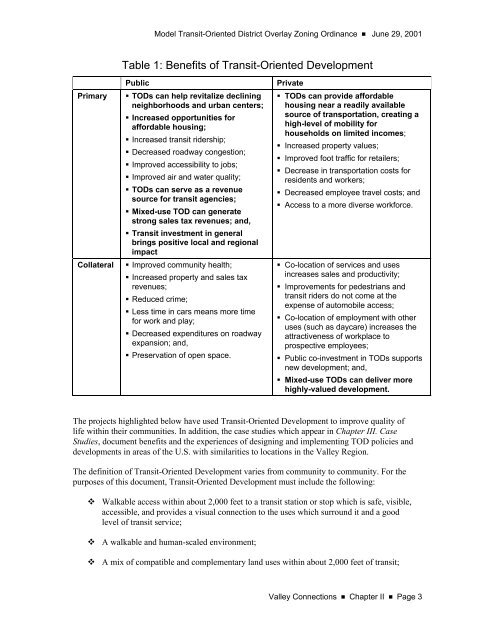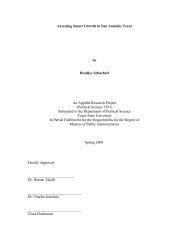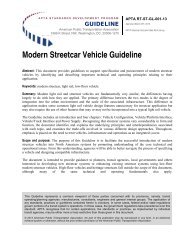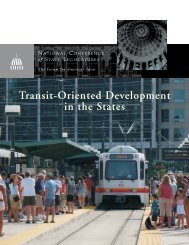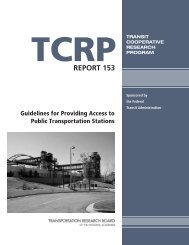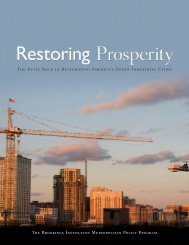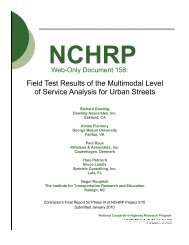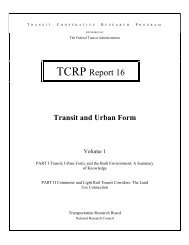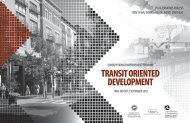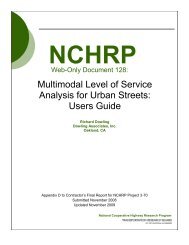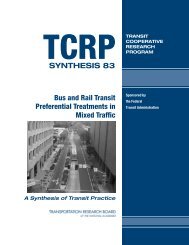Model TOD Zoning Ordinance (PDF, 3.7 MB) - Reconnecting America
Model TOD Zoning Ordinance (PDF, 3.7 MB) - Reconnecting America
Model TOD Zoning Ordinance (PDF, 3.7 MB) - Reconnecting America
You also want an ePaper? Increase the reach of your titles
YUMPU automatically turns print PDFs into web optimized ePapers that Google loves.
<strong>Model</strong> Transit-Oriented District Overlay <strong>Zoning</strong> <strong>Ordinance</strong> ■ June 29, 2001Table 1: Benefits of Transit-Oriented DevelopmentPrimaryCollateralPublic <strong>TOD</strong>s can help revitalize decliningneighborhoods and urban centers; Increased opportunities foraffordable housing; Increased transit ridership; Decreased roadway congestion; Improved accessibility to jobs; Improved air and water quality; <strong>TOD</strong>s can serve as a revenuesource for transit agencies; Mixed-use <strong>TOD</strong> can generatestrong sales tax revenues; and, Transit investment in generalbrings positive local and regionalimpact Improved community health; Increased property and sales taxrevenues; Reduced crime; Less time in cars means more timefor work and play; Decreased expenditures on roadwayexpansion; and, Preservation of open space.Private <strong>TOD</strong>s can provide affordablehousing near a readily availablesource of transportation, creating ahigh-level of mobility forhouseholds on limited incomes; Increased property values; Improved foot traffic for retailers; Decrease in transportation costs forresidents and workers; Decreased employee travel costs; and Access to a more diverse workforce. Co-location of services and usesincreases sales and productivity; Improvements for pedestrians andtransit riders do not come at theexpense of automobile access; Co-location of employment with otheruses (such as daycare) increases theattractiveness of workplace toprospective employees; Public co-investment in <strong>TOD</strong>s supportsnew development; and, Mixed-use <strong>TOD</strong>s can deliver morehighly-valued development.The projects highlighted below have used Transit-Oriented Development to improve quality oflife within their communities. In addition, the case studies which appear in Chapter III. CaseStudies, document benefits and the experiences of designing and implementing <strong>TOD</strong> policies anddevelopments in areas of the U.S. with similarities to locations in the Valley Region.The definition of Transit-Oriented Development varies from community to community. For thepurposes of this document, Transit-Oriented Development must include the following: Walkable access within about 2,000 feet to a transit station or stop which is safe, visible,accessible, and provides a visual connection to the uses which surround it and a goodlevel of transit service; A walkable and human-scaled environment; A mix of compatible and complementary land uses within about 2,000 feet of transit;Valley Connections ■ Chapter II ■ Page 3


